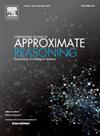软学习概率电路
IF 3
3区 计算机科学
Q2 COMPUTER SCIENCE, ARTIFICIAL INTELLIGENCE
引用次数: 0
摘要
概率电路(pc)是一个突出的易处理的概率模型,允许广泛的精确推断。本文主要关注用于训练pc的主要算法LearnSPN,由于其效率,性能和易用性,特别是对于表格数据,可以说是一个黄金标准。在温和的假设下,我们证明了LearnSPN是贪婪似然最大化器。虽然pc中的推理可能使用整个电路结构来处理查询,但LearnSPN应用硬方法来学习pc,在每个求和节点上通过一个且只有一个子节点/边传播数据点,就像在硬聚类过程中一样。本文提出了一种新的学习方法SoftLearn,该方法采用软聚类方法诱导PC机学习。我们研究了这种学习-推理兼容性在pc中的影响。我们的实验表明,SoftLearn在许多情况下都优于LearnSPN,产生了更好的可能性和更好的样本。我们还分析了可比较的可处理模型,以突出软/硬学习和模型查询之间的差异。本文章由计算机程序翻译,如有差异,请以英文原文为准。
Soft learning probabilistic circuits
Probabilistic Circuits (PCs) are prominent tractable probabilistic models, allowing for a wide range of exact inferences. This paper focuses on a main algorithm for training PCs, LearnSPN, arguably a gold standard due to its efficiency, performance, and ease of use, in particular for tabular data. We show that LearnSPN is a greedy likelihood maximizer under mild assumptions. While inferences in PCs may use the entire circuit structure for processing queries, LearnSPN applies a hard method for learning PCs, propagating at each sum node a data point through one and only one of the children/edges as in a hard clustering process. We propose a new learning procedure named SoftLearn, that induces a PC using a soft clustering process. We investigate the effect of this learning-inference compatibility in PCs. Our experiments show that SoftLearn outperforms LearnSPN in many situations, yielding better likelihoods and arguably better samples. We also analyze comparable tractable models to highlight the differences between soft/hard learning and model querying.
求助全文
通过发布文献求助,成功后即可免费获取论文全文。
去求助
来源期刊

International Journal of Approximate Reasoning
工程技术-计算机:人工智能
CiteScore
6.90
自引率
12.80%
发文量
170
审稿时长
67 days
期刊介绍:
The International Journal of Approximate Reasoning is intended to serve as a forum for the treatment of imprecision and uncertainty in Artificial and Computational Intelligence, covering both the foundations of uncertainty theories, and the design of intelligent systems for scientific and engineering applications. It publishes high-quality research papers describing theoretical developments or innovative applications, as well as review articles on topics of general interest.
Relevant topics include, but are not limited to, probabilistic reasoning and Bayesian networks, imprecise probabilities, random sets, belief functions (Dempster-Shafer theory), possibility theory, fuzzy sets, rough sets, decision theory, non-additive measures and integrals, qualitative reasoning about uncertainty, comparative probability orderings, game-theoretic probability, default reasoning, nonstandard logics, argumentation systems, inconsistency tolerant reasoning, elicitation techniques, philosophical foundations and psychological models of uncertain reasoning.
Domains of application for uncertain reasoning systems include risk analysis and assessment, information retrieval and database design, information fusion, machine learning, data and web mining, computer vision, image and signal processing, intelligent data analysis, statistics, multi-agent systems, etc.
 求助内容:
求助内容: 应助结果提醒方式:
应助结果提醒方式:


